Tang
The tang has a sharp spine to defend itself
Advertisement
Tang Scientific Classification
Read our Complete Guide to Classification of Animals.
Tang Conservation Status
Tang Facts
- Main Prey
- Plankton, algae, and sometimes meat
- Group Behavior
- School
- Fun Fact
- The tang has a sharp spine to defend itself
- Biggest Threat
- Loss of coral reefs
- Most Distinctive Feature
- The brightly colored body
- Distinctive Feature
- Pointed snout and razor-sharp scalpel at the base of their tail
- Other Name(s)
- Surgeonfish or unicornfish
- Gestation Period
- A day or two
- Habitat
- Coral reefs and open ocean
- Predators
- Groupers, tuna, snappers, and barracuda
- Diet
- Omnivore
- Favorite Food
- Algae
- Type
- Ray-finned fish
- Common Name
- Tang
- Number Of Species
- 75
- Average Clutch Size
- 40000
- Slogan
- Found around shallow coral reefs!
The Tang fish is highly sought after by aquarium owners all over the world.
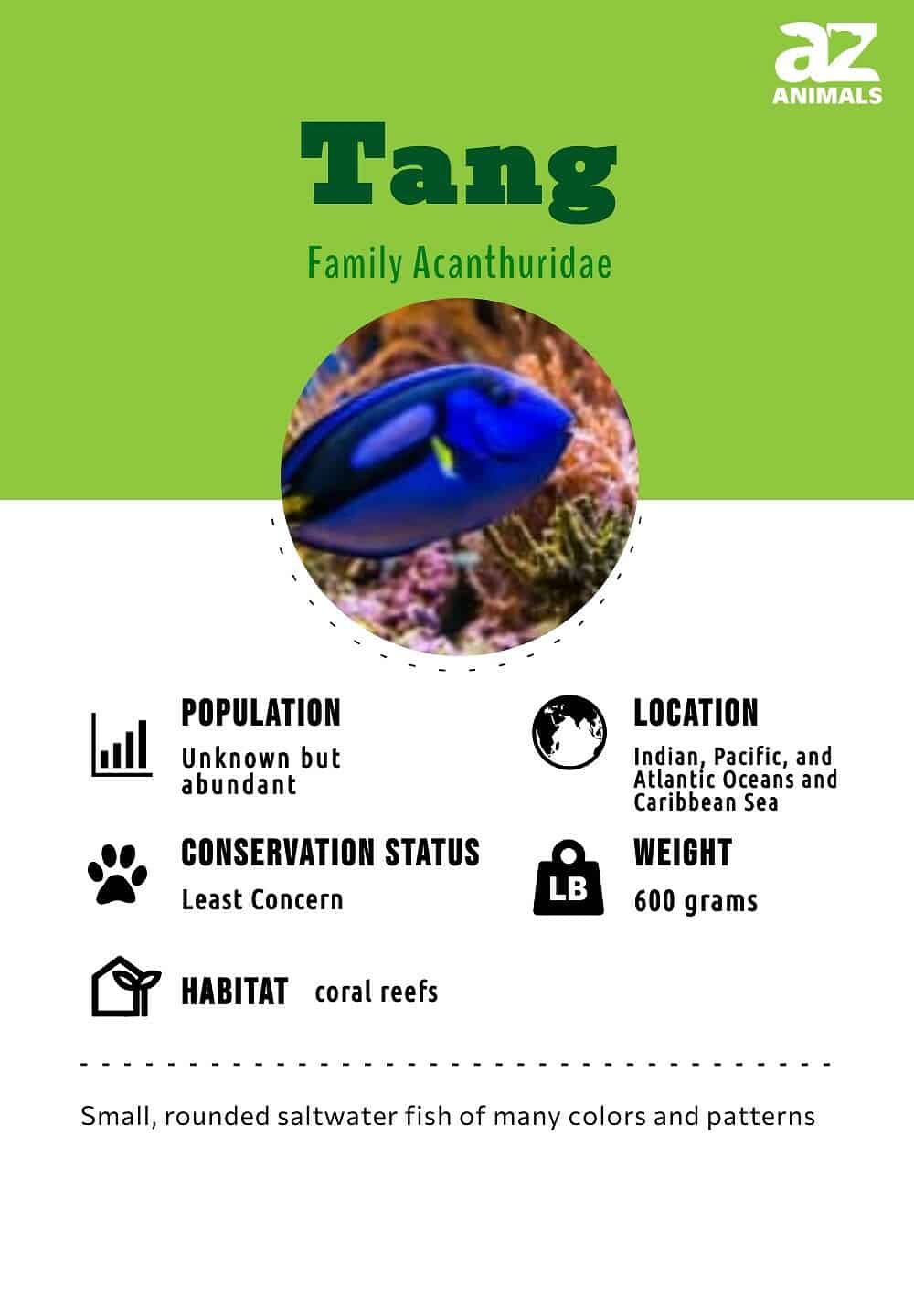
With its brightly colored body and stark patterns, the tang makes for an incredibly vivid display in the home. It is well-adapted for its natural habitat in the coral reefs. This can make it a little difficult to keep in an artificial environment. But for those with the budget and inclination to take care of its needs, the tang is a very rewarding aquarium fish.
An Incredible Fish: 3 Tang Facts!
- Tang fish prefer to travel and feed together in large schools, perhaps as a means of overwhelming other fish that jealously protect algae spots.
- Some species have the ability to lie motionless, as if dead, until a predator passes.
- The tang’s bright colors come from special crystalline cells in the skin. Some tang can modify their colors based on stheir stress level or environmental conditions.
Classification and Scientific Name
The tang is a family of fish that goes by the scientific name of Acanthuridae. This is derived from the Greek words akantha and oura, which roughly translate to thorn and tail. It belongs to the order of Perciformes, one of the most diverse animal orders in the world. Included in the family Acanthuridae are surgeonfishes, tangs, and unicornfishes. The Royal Blue Tang/Palette surgeonfish (Paracanthurus hepatus) is the only member of the genus Paracanthurus.
Species
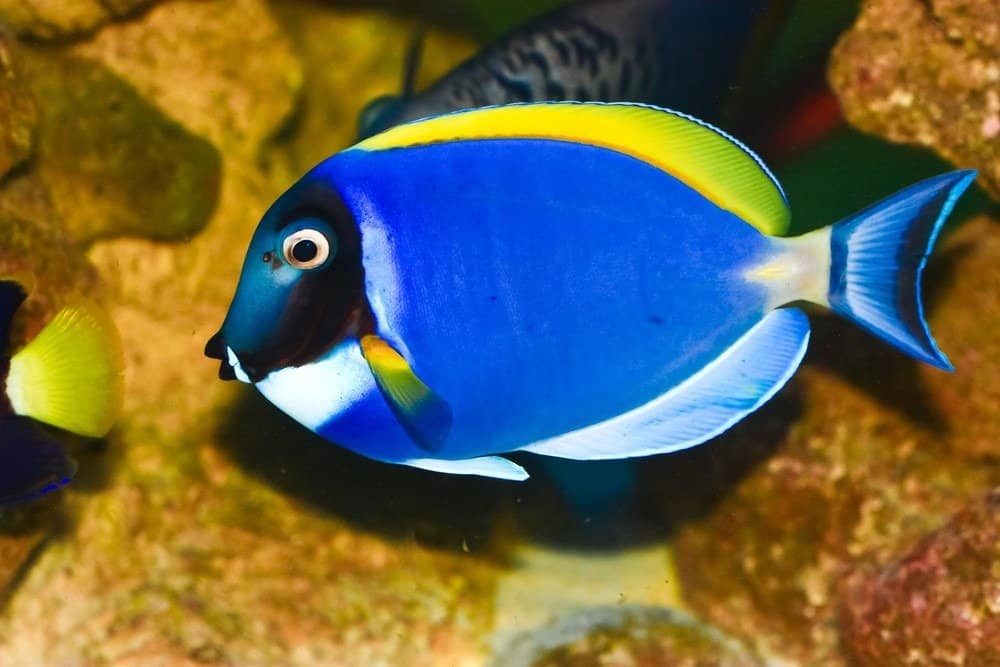
This powder blue tang is representative of the over 80 species of tang fish.
©Nantawat Chotsuwan/Shutterstock.com
There are over 80 species in the family of Acanthuridae, plus many more extinct types known from the fossil record. Many of them go by the name of surgeonfish or doctorfish or unicorn fish, but there isn’t much to distinguish these types from the true tang.
- Blue Tang: Also known as the surgeonfish or the hippo tang, and many other names, this species lives in the Indian and Pacific Oceans. It has a remarkable bright blue color with a yellow tail and black markings. In the movie Finding Nemo, the fish called Dory is a blue tang.
- Yellow Tang: This species has an all-yellow body and a narrow “nose.” It is one of the most popular aquarium fish in the world.
- Convict Tang: With its white body (fading to yellow near the back) and black stripes, it’s easy to see how this species got its name.
- Red Sea Sailfin Tang: The sailfin is aptly named. The highly elevated dorsal and anal fins have the appearance of gigantic sails. The sailfin’s blue body is also covered with dark blue bands and yellow-orange stripes and spots.
- Clown Surgeonfish: Also known as the lined or striped surgeonfish, the clown surgeonfish has alternating blue and yellow stripes all over its body. The clown surgeonfish has a wide range between East Africa and Hawaii.
Appearance
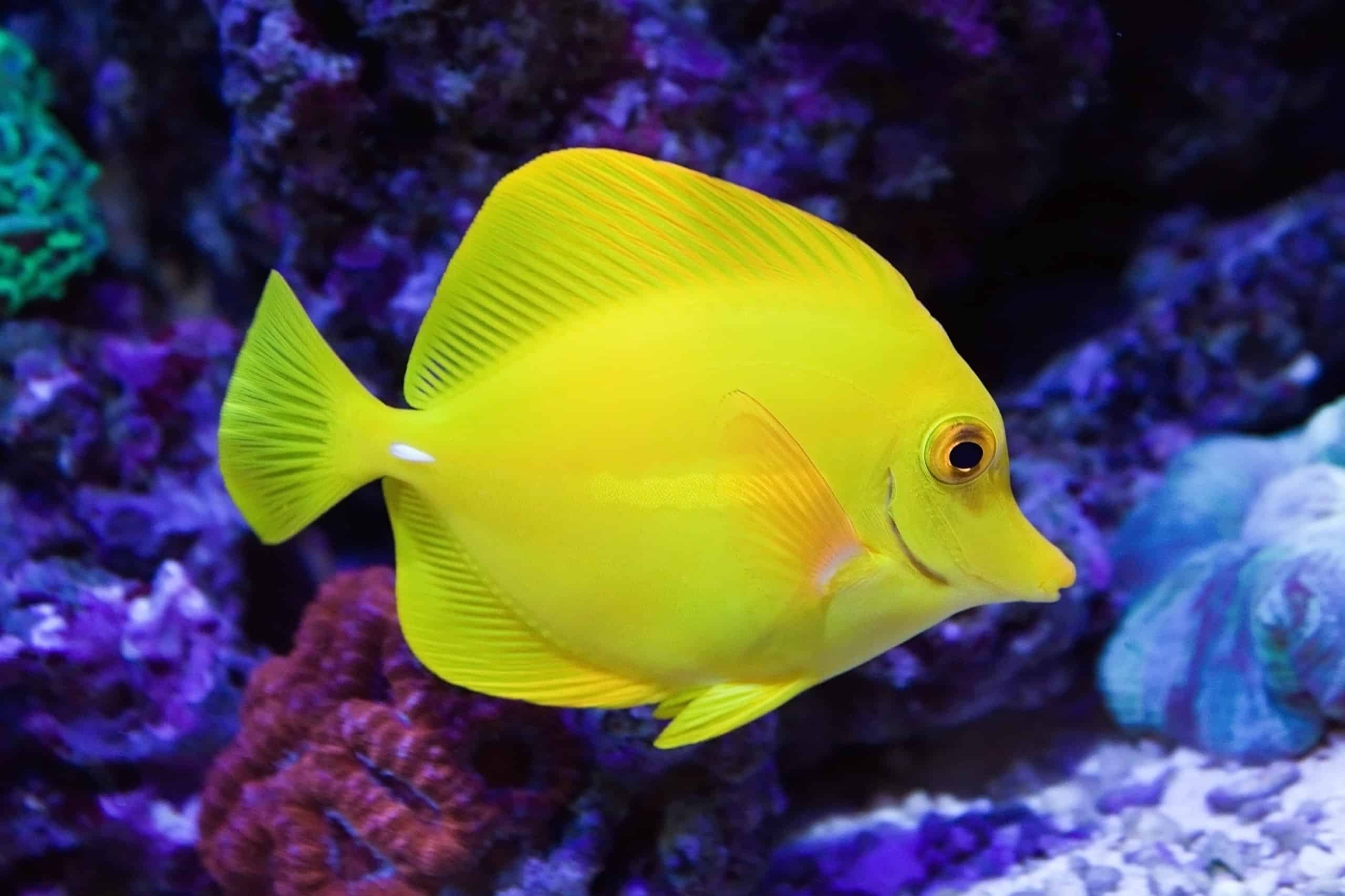
The yellow tang is another example of the bright colors found among the fish family.
©mexrix/Shutterstock.com
The tang is a small, rounded saltwater fish with all manner of bright colors and patterns adorning its body. The sheer diversity of each species is truly remarkable. There is almost nothing else like it in the animal kingdom. Many theories have been suggested for why tropical fish are so brightly colored, but it probably has something to do with their coral environment.
In addition to the bright colors, these fish sports a single dorsal fin across the length of its back and another long anal fin along the stomach. Perhaps the most distinctive physical characteristic is the sharp spine (scalpel) located on either side of the tail for protecting itself against predators. It also serves the purpose of allowing the tang to duel another male to establish dominance.
Members of the tang family almost never grow larger than 2 feet (with few exceptions such as the 3-foot long whitemargin unicornfish). Most species are less than 10 inches long from head to tail.
Distribution, Population, and Habitat

Tangs are endemic to tropical regions in the Indian, Pacific, and Atlantic Oceans as well as the Caribbean Sea.
©Dobermaraner/Shutterstock.com
Most members of the tang family are endemic to the tropical regions in the Indian and Pacific Oceans, as well as the Atlantic Ocean and the Caribbean Sea. The coral reef often provides an oasis for these vulnerable types of fish. When threatened, it can dip into small nooks and crevices in the reefs. These fish is incredibly abundant around the world’s oceans. The IUCN Red List considers many of them to be species of least concern. The loss of their prey from overfishing has contributed to the success of the tang. However, as more coral reefs die off from the effects of climate change, this could put stress on these fish.
Predators and Prey
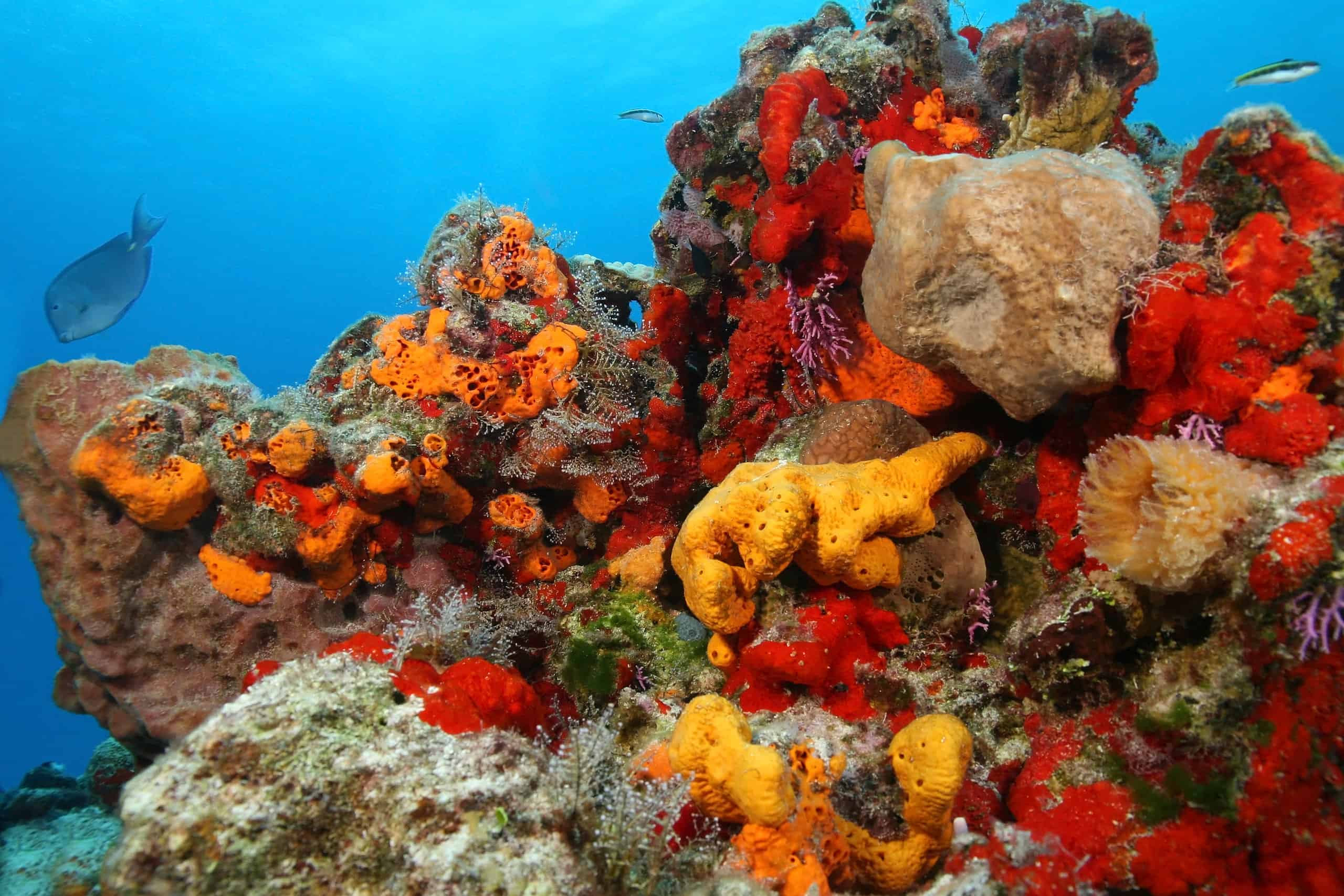
Tangs are an important intermediary fish in the coral reef food chain.
©Brian Lasenby/Shutterstock.com
Tangs are an important intermediary fish in the coral reef food chain. They take in vital resources from plant matter and also keep algae levels down to prevent them from suffocating the reefs. They are also an important source of food for secondary consumers in the food chain.
What does the tang eat?
Most species of tang are herbivorous consumers that constantly move along the surface of coral reefs and graze on algae and plankton growing in the shallower waters. Some species supplement this with small meat.
What eats the tang?
The main predators of most tang are large carnivorous fish such as tuna, barracuda, groupers, and snappers. The sharp scalpels at its tail are its main means of defense against predators.
Reproduction and Lifespan
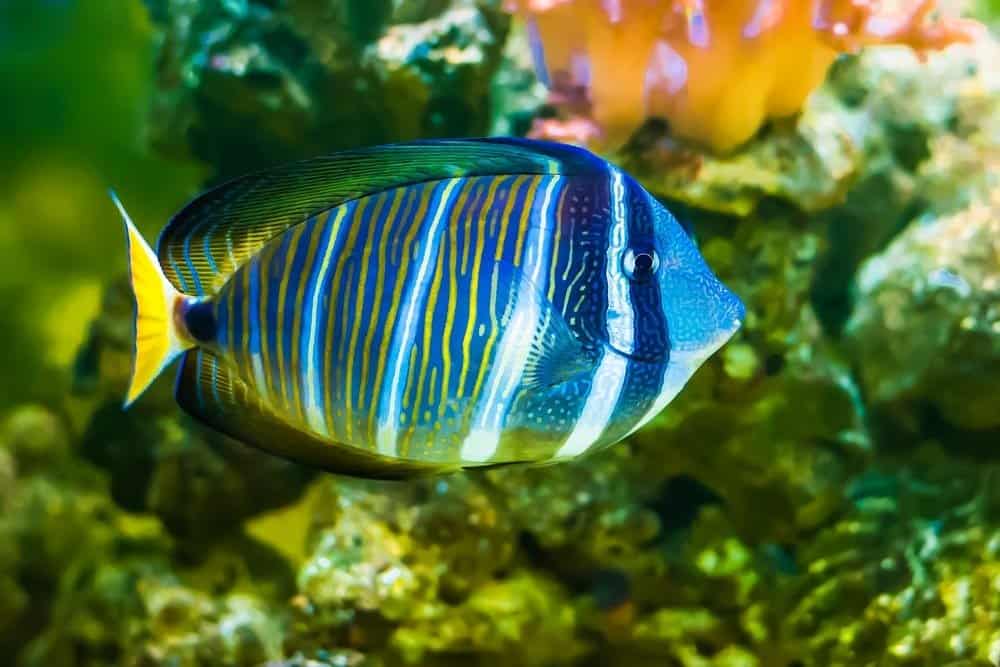
It takes up to a year for the juvenile tang to reach sexual maturity like this adult sailfin tang.
©TigerStocks/Shutterstock.com
The tang as a family has many different methods of reproduction. Most are broadcast spawners that maximize the chances of fertilization by releasing many thousands of eggs and sperm into the water at the same time, where they mix together.
The juveniles usually hatch in a matter of days and sometimes lack even rudimentary eyes, mouths, or a heartbeat. Some species spawn in protective coral or mangrove forests and then move toward the open coral surface as they age. It takes up to a year for the juvenile tang to reach sexual maturity. These are relatively long-living fish that may have a life expectancy of a few decades in the wild.
Fishing and Cooking
The tang is rarely used in human cuisines. The flesh of some species (like the regal blue tang) is poisonous and should be avoided completely. The fish does not produce this poison itself. Instead, it ingests the toxin from another organism and then passes it on to whatever eats it. Symptoms of the toxin include diarrhea, low blood pressure, and reduced heart hate. Death only occurs in 1 out of 1,000 cases.
Tang FAQs (Frequently Asked Questions)
Are tangs hardy fish?
As a tropical coral fish, the tang has very specific needs that may make it difficult to keep in captivity. There are a few things to keep in mind. First of all, the tank should have a powerful filtration system. You can combine this with an optional ozone producer or a refugium chemical filtration system to maintain a healthy ecosystem in the tank. Constant water movement is also recommended to simulate the tang’s natural environment. You should always be on the lookout for possible signs of health problems, including spots, labored breathing, lethargy, and loss of appetite. If you follow all of the recommendations, then the tang may even end up outliving many other pets.
What fish are compatible with tangs?
The tang is actually compatible with lots of other saltwater fish, including angelfish, lionfish, blennies, gobies, small groupers, etc. But conflicts may arise if you’re not careful about how you arrange the tank.
Are tangs aggressive?
Yes, tangs do exhibit some aggression toward other fish, and because of their scalpel, any fight can quickly turn dangerous or deadly. To minimize this behavior, it is a good idea to buy a large tank with plenty of swimming room and hiding spots (preferably more than 100 gallons) and, if necessary, place a divider in it. It’s a good idea to introduce the tang into the tank last before it can claim territory for itself. Your fish are also less likely to engage in conflict if they’re happy and well-fed. Remember that most tangs are caught from the wild, and the home aquarium is a new and bewildering habitat for them.
How many species of tangs are there?
There are approximately 75 species of tang currently living. However, some taxonomists put the count at more than 80.
What is the lifespan of a tang fish?
The life expectancy varies, but some species can live up to 30 years in the wild and some 20 years in captivity (where they’re more likely to experience diseases).
Are Tangs herbivores, carnivores, or omnivores?
Tangs are Omnivores, meaning they eat both plants and other animals.
What Kingdom do Tangs belong to?
Tangs belong to the Kingdom Animalia.
What phylum do Tangs belong to?
Tangs belong to the phylum Chordata.
What class do Tangs belong to?
Tangs belong to the class Actinopterygii.
What family do Tangs belong to?
Tangs belong to the family Acanthuridae.
What order do Tangs belong to?
Tangs belong to the order Perciformes.
What type of covering do Tangs have?
Tangs are covered in Scales.
In what type of habitat do Tangs live?
Tangs live in coral reefs and open oceans.
What is the main prey for Tangs?
Tangs eat plankton, algae, and sometimes meat.
What are some predators of Tangs?
Predators of Tangs include groupers, tuna, snappers, and barracudas.
What are some distinguishing features of Tangs?
Tangs have pointed snouts and razor-sharp scalpels at the base of their tails.
What is the average clutch size of a Tang?
Tangs typically lay 40,000 eggs.
What is an interesting fact about Tangs?
Tangs are found around shallow coral reefs!
What is the biggest threat to the Tang?
The biggest threat to the Tang is loss of coral reefs.
What is another name for the Tang?
The Tang is also called the surgeonfish or unicornfish.
How do Tangs have babies?
Tangs lay eggs.
Thank you for reading! Have some feedback for us? Contact the AZ Animals editorial team.
Sources
- Britannica, Available here: https://www.britannica.com/animal/surgeonfish
- Seaworld Parks & Entertainment, Available here: https://seaworld.org/animals/facts/bony-fish/blue-tang/
- Tropical Fish Magazine, Available here: https://www.tfhmagazine.com/articles/saltwater/tips-and-tricks-for-keeping-tangs-full

















